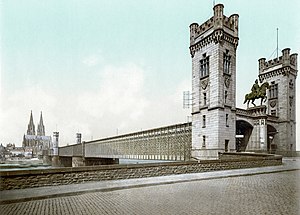Cathedral Bridge
Coordinates: 50 ° 56 ′ 29 ″ N , 6 ° 57 ′ 58 ″ E
| Cathedral Bridge | ||
|---|---|---|
| Cathedral Bridge, around 1900 | ||
| use | Railway bridge , road bridge | |
| Convicted | Deutz-Giessen Railway | |
| Subjugated | Rhine | |
| place | Cologne | |
| construction | Lattice girder | |
| width | 16.73 m | |
| Number of openings | 6th | |
| Longest span | 103.2 m | |
| building-costs | 4 million thalers | |
| start of building | 1855 | |
| completion | 1859 | |
| opening | October 3, 1859 | |
| closure | 1909 | |
| location | ||
|
|
||
|
Replaced by the Hohenzollern Bridge |
||
The Dombrücke was a railway and road bridge over the Rhine in Cologne and the direct predecessor of today's Hohenzollern Bridge . It was built from 1855 and opened at the beginning of October 1859 together with Cologne's first “ Centralbahnhof ” on Maximinenstrasse. At the same time, a new track at ground level was laid through the old town .
With the new construction of the main train station in 1894, the cathedral bridge was no longer sufficient for the increased traffic and was replaced by the Hohenzollern bridge, which opened in 1911, after around fifty years of operation.
location
The cathedral bridge was at Rheinstrom kilometer 688.5 in the longitudinal axis of Cologne Cathedral . The position of the southern part of today's Hohenzollern Bridge roughly corresponds to that of the railway bridge part of the Dombrücke.
meaning
The bridge was the second railway bridge over the Rhine after the much shorter one in Waldshut , which had been opened a few months earlier on August 18, 1859. The cathedral bridge was also called the “fixed bridge” because it was the first “fixed” Rhine crossing between Basel and the Netherlands after the Roman bridge from the 4th century . Before that there had been a "flying bridge" / Gierponte , a shuttle ferry , in the Middle Ages , and a pontoon bridge in Prussian times .
construction
Until the cathedral bridge was built, the various railway lines on the right and left of the Rhine ended on the opposite banks of the Rhine without any direct connection. Travelers and goods had to cross the Rhine over a ship bridge or by ferry.
In particular, the Cologne-Mindener Eisenbahn-Gesellschaft pushed for a bridge to be built and eventually became the owner of the bridge. Due to the increasing traffic with the areas on the right bank of the Rhine, the city was interested in a road bridge and contributed to the costs. In 1847, the Cologne City Council turned to King Friedrich Wilhelm IV , who, through the Ministry of Trade, Industry and Public Works, commissioned the Prussian senior building officer Lentze with the planning. He designed a double bridge, a road bridge (south, upstream) and a double-track railway bridge (north, downstream). The street layout ended on the western side with a straight ramp northeast of Cologne Cathedral.
The earthworks began on June 6, 1855, the foundation stone was laid on October 3, 1855, and the bridge was inaugurated on October 3, 1859. The bridge portals designed by the Berlin court building officer Heinrich Strack are said to have been completed only after the official commissioning . They were built in gray sandstone from Udelfang .
Technical parameters
The bridge spanned the Rhine with four openings, each 99 meters long. The width of the bridge was 16.73 m (of which 8.16 m for double-track railway operations, 8.47 m for road bridges). The iron construction came from the hydraulic engineering inspector Hermann Lohse . It consisted of a total of eight lattice girders (two next to each other and four behind each other), the sides of which consisted of a close-meshed network of diagonal bars. Because the bridge was reminiscent of a cage and could also be closed with heavy iron gates, it was also popularly known as the “mousetrap” ( dialect : “Muusfall”). Forty years later, the construction costs were put at almost 12 million marks, which means that in 1859 it was almost 4 million (Prussian) thalers .
Individual evidence
- ^ Judith Breuer, The First Prussian Railway Bridges , 1988, p. 58.
- ^ Johannes Kurz (ed.): The German Federal Railroad in words and pictures . Bonn 1953, p. 34.
literature
- Judith Breuer: The first Prussian railway bridges . Dirschau Marienburg Cologne. Lüneburg 1988 (book accompanying the exhibition of the East Prussian State Museum ).
- Hermann Maertens: The German statue-monuments of the XIX. Century . Stuttgart 1892, p. 59 .
- Georg Mehrtens: The German bridge building in the XIX. Century . Springer, Berlin 1900.
- Hans-Wolfgang Scharf: Railway Rhine bridges in Germany . 1st edition. EK-Verlag, Freiburg 2003, ISBN 978-3-88255-689-6 , p. 214-219 .
Web links
- Cathedral Bridge. In: Structurae
- Obituary Wilhelm Benoit, Zentralblatt der Bauverwaltung, 34th year 1914, No. 25, p. 200
- Herrmann Lohse: The Rhine Bridge near Cologne. In: Zeitschrift für Bauwesen , Volume 7, 1857, Column 307-314 ( digitized version) and in Volume 13, 1863, Column 175-196 ( digitized version ) with atlas , ( Sheet 31 to Sheet 39 ), each on digital.zlb.de




